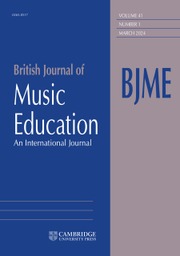No CrossRef data available.
Article contents
‘NAOUIEDCT’ and ‘RCSSEOEUR’: harmonising complexity in the South African landscape of music literacy education in secondary schools
Published online by Cambridge University Press: 12 December 2024
Abstract
This article explores the multifaceted landscape of music literacy education in South African secondary schools through an anagrammatic lens. Music literacy education is symbolised by the anagrams ‘NAOUIEDCT’ and ‘RCSSEOEUR’, encapsulating resource-related, cultural and pedagogical complexities. This comparison of music literacy education to anagrams creates an interesting analogy that can shed light on the complexity and challenges inherent in the situation. It aims to unravel these complexities, like solving a multifaceted puzzle. Thus, the result of this qualitative interpretive research project is the transformation of a complex challenge (conundrum) into symbolic puzzles (anagrams), aiming to decipher the intricacies of music literacy education. This methodology offers an approach to foster engagement and collaborative work toward future solutions. Through a comprehensive exploration, this research aims to unravel the layers of challenges inherent in Music Education, offering insights and recommendations for a nuanced and enriched educational experience. The data for this research project were collected through semi-structured interviews and, consequently, a thematic content analysis was carried out, first in a descriptive level of analysis, followed by a conceptual level of analysis. Computer-aided qualitative analysis software, namely ATLAS.tiTM23, played a valuable and significant role in both the literature review and thematic content analysis phases of this study.
- Type
- Article
- Information
- Copyright
- © The Author(s), 2024. Published by Cambridge University Press



